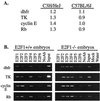The identification of E2F1-specific target genes
- PMID: 11904439
- PMCID: PMC122619
- DOI: 10.1073/pnas.062047499
The identification of E2F1-specific target genes
Abstract
The E2F family of transcriptional regulators consists of six different members. Analysis of E2F-regulated promoters by using cultured cells suggests that E2Fs may have redundant functions. However, animal studies have shown that loss of individual E2Fs can have distinct biological consequences. Such seemingly conflicting results could be due to a difference in E2F-mediated regulation in cell culture vs. animals. Alternatively, there may be genes that are specifically regulated by an individual E2F which have not yet been identified. To investigate this possibility further, we have analyzed gene expression in E2F1 nullizygous mice. We found that loss of E2F1 did not cause changes in expression of known E2F target genes, suggesting that perhaps E2F1-specific promoters are distinct from known E2F target promoters. Therefore, we used oligonucleotide microarrays to identify mRNAs whose expression is altered on loss of E2F1. We demonstrate by chromatin immunoprecipitation that several of the promoters that drive expression of the deregulated mRNAs selectively recruit E2F1, but not other E2Fs, and this recruitment is via an element distinct from a consensus E2F binding site. To our knowledge, these are as yet undocumented examples of promoters being occupied in asynchronously growing cells by a single E2F family member. Interestingly, the E2F1-specific target genes that we identified encode proteins having functions quite different from the function of known E2F target genes. Thus, whereas E2F1 may share redundant functions in cell growth control with other E2F family members, it may also play an important biological role distinct from the other E2Fs.
Figures




Similar articles
-
Use of chromatin immunoprecipitation to clone novel E2F target promoters.Mol Cell Biol. 2001 Oct;21(20):6820-32. doi: 10.1128/MCB.21.20.6820-6832.2001. Mol Cell Biol. 2001. PMID: 11564866 Free PMC article.
-
Distinct recruitment of E2F family members to specific E2F-binding sites mediates activation and repression of the E2F1 promoter.Oncogene. 2003 Oct 23;22(48):7632-41. doi: 10.1038/sj.onc.1206840. Oncogene. 2003. PMID: 14576826
-
Combinatorial gene control involving E2F and E Box family members.EMBO J. 2004 Mar 24;23(6):1336-47. doi: 10.1038/sj.emboj.7600134. Epub 2004 Mar 4. EMBO J. 2004. PMID: 15014447 Free PMC article.
-
Regulation of the G1/S transition phase in mesangial cells by E2F1.Kidney Int. 1999 Oct;56(4):1238-41. doi: 10.1046/j.1523-1755.1999.00705.x. Kidney Int. 1999. PMID: 10504464 Review.
-
The E2F family: specific functions and overlapping interests.EMBO J. 2004 Dec 8;23(24):4709-16. doi: 10.1038/sj.emboj.7600481. Epub 2004 Nov 11. EMBO J. 2004. PMID: 15538380 Free PMC article. Review.
Cited by
-
Arborinine from Glycosmis parva leaf extract inhibits clear-cell renal cell carcinoma by inhibiting KDM1A/UBE2O signaling.Food Nutr Res. 2022 Sep 16;66. doi: 10.29219/fnr.v66.8714. eCollection 2022. Food Nutr Res. 2022. PMID: 36185617 Free PMC article.
-
Ing1 functions in DNA demethylation by directing Gadd45a to H3K4me3.Genes Dev. 2013 Feb 1;27(3):261-73. doi: 10.1101/gad.186916.112. Genes Dev. 2013. PMID: 23388825 Free PMC article.
-
Identification of E2F1 as an important transcription factor for the regulation of tapasin expression.J Biol Chem. 2010 Oct 1;285(40):30419-26. doi: 10.1074/jbc.M109.094284. Epub 2010 Jul 27. J Biol Chem. 2010. PMID: 20663889 Free PMC article.
-
p110 CUX1 cooperates with E2F transcription factors in the transcriptional activation of cell cycle-regulated genes.Mol Cell Biol. 2008 May;28(10):3127-38. doi: 10.1128/MCB.02089-07. Epub 2008 Mar 17. Mol Cell Biol. 2008. PMID: 18347061 Free PMC article.
-
Regulation of photoreceptor gene expression by the retinal homeobox (Rx) gene product.Dev Biol. 2010 Mar 15;339(2):494-506. doi: 10.1016/j.ydbio.2009.12.032. Epub 2010 Jan 7. Dev Biol. 2010. PMID: 20060393 Free PMC article.
References
Publication types
MeSH terms
Substances
Grants and funding
LinkOut - more resources
Full Text Sources
Other Literature Sources

